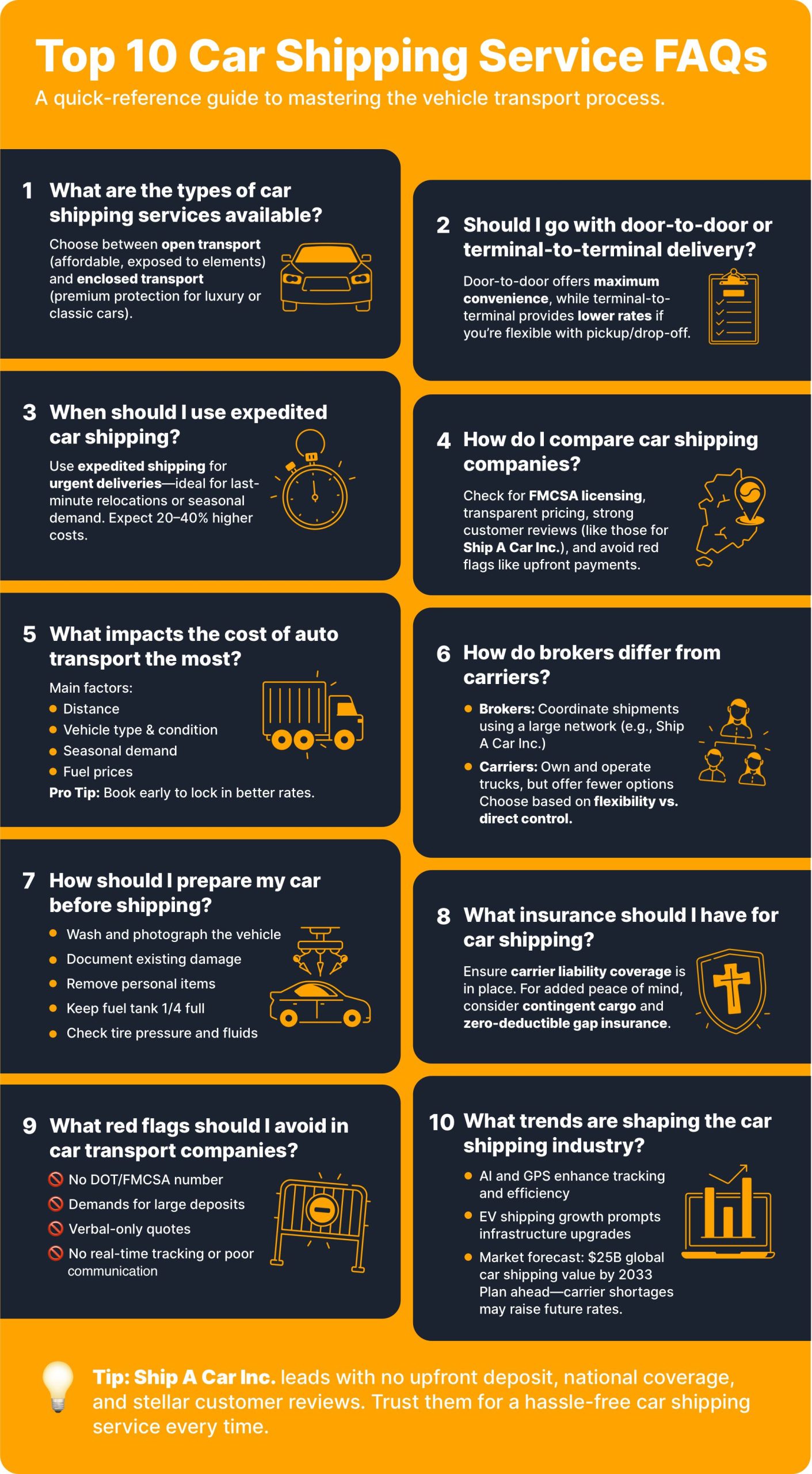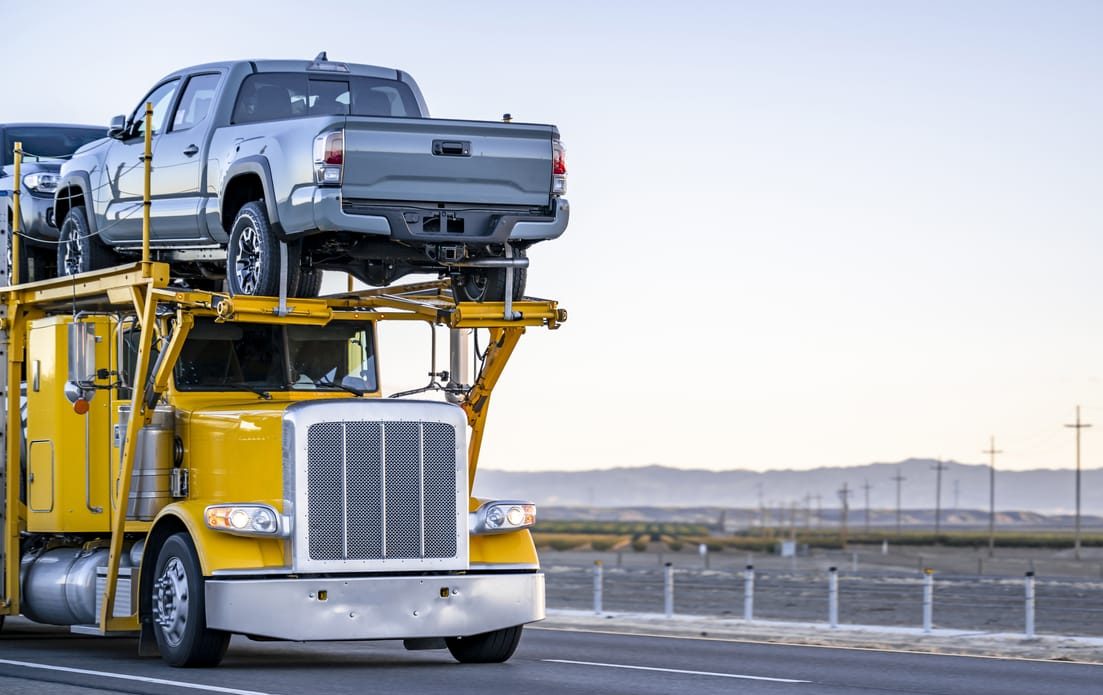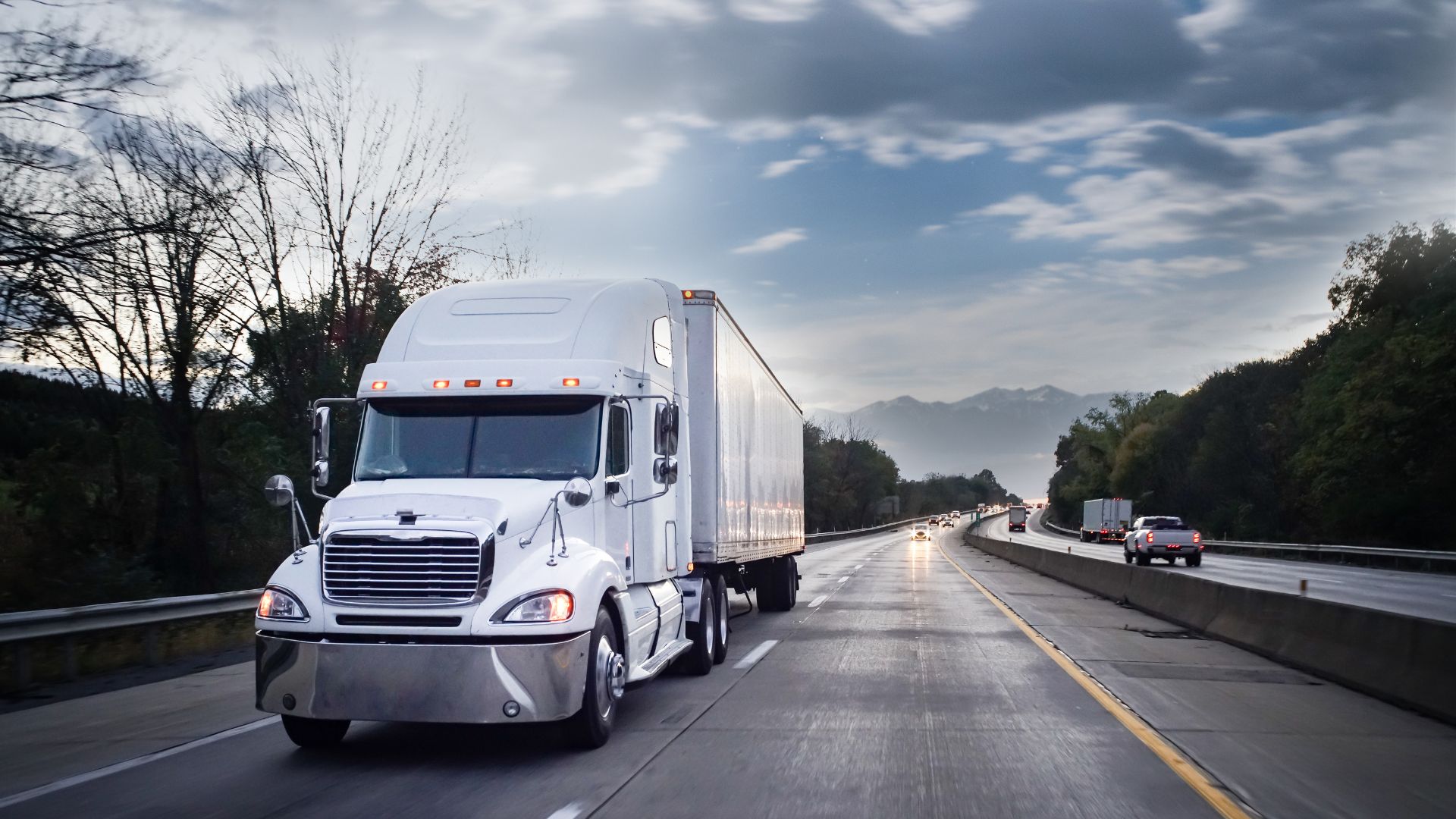Choosing the ideal car transporter requires balancing cost, protection, and convenience to ensure your vehicle arrives safely and on time. This guide empowers you with clear comparisons of transport methods, company evaluation criteria, cost factors, broker versus carrier distinctions, preparation steps, insurance options, and industry trends. Readers will learn how to compare car shipping service comparisons effectively, evaluate providers like Ship A Car Inc with its zero-upfront-deposit policy and transparent pricing, and select the best solution for domestic or business auto transport across the US.

Car transport service types define how vehicles move from pickup to delivery, influencing price, protection, and timing. Understanding each option helps match transport methods to vehicle value and shipping urgency, for example, open carriers for budget moves or enclosed trailers for luxury models.
Open car transport ships vehicles on trailers exposed to the elements, reducing costs by hauling multiple cars at once. This method suits standard sedans, SUVs, and trucks that tolerate road debris and weather.
Pros:
- Lower per-mile rates
- Wide carrier availability
- Faster scheduling
Cons:
- Exposure to dust, rain, and road wear
- Limited protection for collectibles
Open transport offers cost savings for everyday vehicles, making it the economical choice for most customers and providing reliable service across all 50 states.
Enclosed car transport encloses each vehicle within a covered trailer, shielding high-value, classic, or exotic cars from debris, salt, and UV exposure. This method increases shipping costs by up to 50 percent but ensures maximum protection.
Key benefits:
- Full weather and road-debris barrier
- Reduced risk of scratches or chips
- Privacy for specialty vehicles
Collectors and luxury-car owners rely on enclosed carriers to preserve showroom condition, with car transporters like Ship A Car Inc offering FMCSA-licensed enclosed options nationwide.
Door-to-door and terminal-to-terminal services vary in pickup/drop-off points and cost. The table below compares convenience and typical pricing for each option.
Service Option | Pickup & Delivery Location | Cost Impact |
|---|---|---|
At customer address | Higher due to direct routing | |
Terminal-to-Terminal | Designated carrier hubs | Lower with consolidated loads |
Door-to-door provides curbside convenience at a premium, while terminal-to-terminal combines multiple shipments at carrier hubs to reduce rates. Selecting between them depends on budget versus delivery flexibility.
Expedited car shipping delivers vehicles within a shortened timeframe, typically one to three days faster than standard schedules. Customers choose this when relocation deadlines, event schedules, or seasonal surges demand speed. Expedited services incur surcharges ranging from 20–40 percent of the base rate but guarantee priority loading and dedicated routing to meet tight timelines.

Comparing car shipping companies involves evaluating reputation, licensing, pricing transparency, and red-flag avoidance. A structured comparison ensures you select a transporter with verified credentials, strong reviews, and clear quotes.
A transporter’s reputation summarizes past performance, reflecting reliability, communication, and delivery success. Platforms like BBB, Trustpilot, and Google Reviews reveal common praise or complaints. For example, Ship A Car Inc maintains a 97 percent positive review rate by delivering on promises and providing zero upfront deposits. Verifying reviews helps gauge service quality before booking.
Valid FMCSA registration and a USDOT number confirm a carrier’s legal authority. Insurance coverage, both carrier-provided and contingent cargo policies, protects vehicles against damage or loss during transit. Confirm that your transporter shows FMCSA compliance and offers full insurance, including optional zero-deductible gap protection, to safeguard your investment.

Identifying warning signs prevents unreliable service:
- Lack of FMCSA or DOT credentials.
- Demands for large upfront deposits.
- Vague or verbal-only quotes.
- Poor communication or no tracking updates.
Avoid companies exhibiting these traits to minimize risk and delays.
Transparent quotes break down costs by distance, transport type, vehicle size, and any surcharges. When obtaining multiple car shipping service comparisons, insist on written estimates that list fuel surcharges, expedited fees, and insurance costs. Clear quotes enable accurate budgeting and prevent surprise charges upon delivery.

Auto transport costs vary according to distance, vehicle specifics, market demand, and seasonal trends. Grasping each factor allows you to anticipate quotes and plan shipments more economically.
Longer distances increase mileage charges, while remote pickup or delivery in rural areas often adds a location premium. Urban centers benefit from carrier density and lower extra-mileage fees, so shipping from major cities typically costs less per mile than remote addresses.
Taller, heavier, or oversized vehicles consume more trailer space and reduce load capacity, driving up cost. Inoperable cars require special equipment and labor, adding handling fees. Standard sedans ship at base rates, whereas trucks or non-runners incur surcharges for weight and equipment.
High demand during holiday relocations, snowbird migrations, and new-model releases raises transport rates by up to 25 percent. Fuel price spikes trigger carrier-imposed surcharges tied to national diesel indexes. Booking off-peak or locking in quotes early helps avoid steep seasonal increases.
To reduce expenses while maintaining service standards, follow these steps:
- Book 2–4 weeks in advance to access early-booking rates.
- Choose terminal-to-terminal pickup and drop-off instead of door-to-door.
- Consolidate multiple vehicles on one load when possible.
- Compare at least three written quotes before committing.
Applying these strategies ensures cost efficiency without compromising carrier reliability or insurance protection.

Understanding broker and carrier roles clarifies who manages logistics and who physically hauls vehicles. Choosing the right model affects pricing, flexibility, and accountability.
An auto transport broker acts as a logistics coordinator, sourcing multiple FMCSA-licensed carriers to secure competitive rates. Brokers like Ship A Car Inc negotiate routes, handle paperwork, and monitor shipments, offering customers wider network access and personalized support without owning transport assets.
An auto transport carrier owns and operates the trucks that move vehicles. Carriers provide direct service control and may offer slightly lower base rates by eliminating broker fees. However, carriers have limited route options compared to a broker’s aggregated network.
Compare benefits side by side:
Option | Role | Key Benefit |
|---|---|---|
Broker | Connects customer to multiple carriers | Wider network and competitive quotes |
Carrier | Operates trucks to transport vehicle | Direct billing and potential savings |
Auto transport brokers act as intermediaries, connecting customers with carriers to facilitate vehicle shipping. Brokers offer flexibility and access to a broad network, while carriers provide direct control over the shipping process.
Customers can weigh these differences to determine whether a broker’s broad access or a carrier’s direct control better fits their shipping priorities.

Proper preparation protects your vehicle and ensures a smooth handoff at the carrier. Follow inspection and documentation steps to avoid delays and claims disputes.
Before pickup, complete these actions:
- Clean exterior and interior for clear condition photos.
- Record existing dents, scratches, and mileage.
- Remove personal belongings and aftermarket accessories.
- Check fluid levels and tire pressure.
- Leave only minimal fuel (1/4 tank) for safe handling.
Documenting condition with photos and written notes prevents disputes and accelerates claims resolution if damage occurs.
Review both carrier and contingent insurance policies to confirm coverage limits, deductibles, and exclusions. Opt for zero-deductible gap protection to fill gaps between your carrier’s coverage and your vehicle’s value. Knowing policy details ensures you’re protected in all transit scenarios.

Car shipping insurance covers damage, theft, or loss during transit. Different policy types suit various risk profiles and vehicle values.
Key insurance options include:
- Carrier Liability Insurance covers accidental damage caused by the carrier.
- Contingent Cargo Insurance protects against third-party losses if carrier coverage is insufficient.
- Gap Protection bridges the difference between vehicle value and carrier limits.
- Zero-Deductible Gap Protection ensures no out-of-pocket expenses for covered claims.
Auto transport carriers are required by law to offer insurance, typically including liability and cargo insurance. Cargo insurance coverage for enclosed carriers is often between $250,000 and $300,000.
Full coverage packages combine carrier liability with contingent and gap policies, offering comprehensive protection. Zero-deductible gap protection means you pay no deductible for covered claims, ensuring repair or replacement costs are fully covered up to the vehicle’s market value.

Emerging technologies, sustainability priorities, and market growth shape the next decade of auto transport. Staying informed equips customers and providers to adapt strategies.
The car shipping industry is experiencing increased demand for international car shipping, growing popularity of online platforms, and advancements in technology. Sustainability and specialized services are also becoming more important.
AI-driven route optimization reduces transit time and fuel consumption by analyzing traffic, weather, and load factors. Real-time GPS tracking provides customers and dispatchers with continuous location updates, enhancing transparency and trust throughout shipment.
Growing electric vehicle (EV) adoption prompts carriers to invest in EV-compatible handling equipment and charging infrastructure. Sustainable shipping practices, such as low-emission trucks and carbon-offset programs, are becoming standard in response to environmental regulations and customer demand.
The vehicle shipping services industry in the U.S. had a revenue-based market size of $9.9 billion in 2023. The market is expected to grow due to increased vehicle sales and global trade.
The global vehicle shipping service market is experiencing robust growth, with an estimated market size of $15 billion in 2025 and a projected value of approximately $25 billion by 2033. This growth is driven by increasing vehicle production, global trade, and technological advancements.
Anticipated carrier shortages may elevate rates, underscoring the value of early booking and broker partnerships.

Ship A Car Inc’s blend of FMCSA-licensed carriers, transparent pricing, and zero-upfront-deposit policy positions it as a top choice for individuals and businesses seeking reliable auto transport. By comparing transport types, vetting companies, understanding cost drivers, evaluating broker versus carrier models, preparing vehicles thoroughly, selecting robust insurance, and staying abreast of industry trends, customers can confidently choose the right car transporter for any shipment. Request a personalized car shipping quote today and secure hassle-free vehicle transit with trusted expertise.




